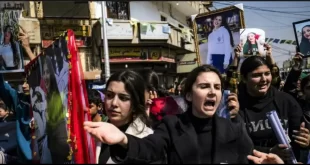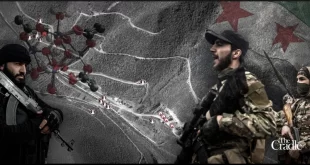Dec 16, 2014, Strategic Culture
If a recent report in the British Guardian is to be believed, then the West is angling for a new pretext to step up its covert war of regime in Syria. The new pretext, it would seem, is that the Damascus government of Bashar al Assad was the main driving force in the creation of the so-called Islamic State (IS) terror network.
The report by Guardian Middle East correspondent Martin Chulov, published on December 11, is riven with contradictions and anomalies. It raises more questions than answers that the author seems strangely indisposed to delve into.
But the upshot is the apparent conclusion that the Syrian government of President Assad is to blame for the rise of IS, or ISIS (Islamic State in Iraq and Syria). That the Syrian army has emerged as the main fighting force on the ground to defeat IS in the latter’s campaign to overthrow the Assad government is right away a troubling question mark over the credibility of the Guardian report.
Nevertheless, if we follow the dubious logic of this narrative, then it would seem to be aimed at providing a «just cause» for Western hostility towards Assad and for the objective of regime change.
IS, an offshoot of the Al Qaeda network, is portrayed in the Western media as «the world’s most menacing terrorist group». It has gained notoriety for its videos purporting to show the execution of Western hostages. The US government has appointed itself as the leader of an international coalition to «wipe out» IS with air strikes on its bases in remote areas of Iraq and Syria.
The efficacy and legality of these US-led air strikes are questionable, and as already noted, it is the Syrian state forces carrying out ground operations that are actually inflicting the heaviest losses on the IS network – the latest being in the eastern city of Deir al Zour.
So, it is at odds, to say the least, that the Guardian should now be casting the Syrian authorities as the originating sponsors of the very network that they are locked in mortal combat with.
The report, headlined ‘ISIS: the inside story’, informs readers that around early 2009 the Syrian government gave the group crucial help in ramping up its insurgency in Iraq. That insurgency, according to the Guardian, then «spilled over» into Syria in 2011, as if by accident. And so we can condemn the «dastardly Syrians» for their own maladroit blowback.
The main source of the story, we are told, is «one of the Islamic State’s senior commanders» who goes by the nom de guerre of Abu Ahmed.
The Guardian correspondent writes: «Syria’s links to the Sunni insurgency in Iraq had been regularly raised by US officials in Baghdad and by the Iraqi government. Both were convinced that the Syrian president, Bashar al-Assad, allowed jihadists to fly into Damascus airport, where military officials would escort them to the border with Iraq».
That «assessment» is largely based on «interrogations» of captured jihadists. In other words, by torture techniques that even the US Senate Intelligence Committee report last week described as «unreliable».
According to the Guardian, the Syrian plot to destabilise Iraq with Sunni extremists was hatched during two top-secret meetings near Damascus during early 2009. The meetings were between Syrian military intelligence, senior members of the Baathist party of President Assad and the jihadists of Al Qaeda in Iraq – the latter being the precursor to the IS network.
The Syrian objective was allegedly to «unsettle the Americans and their plans for Iraq». This was nearly three years before the Americans ended their military occupation of the country at the end of 2011.
Apparently, the Iraqis knew of Syria’s alleged covert involvement and that led to a «poisoning of relations» between the then Iraqi Prime Minister Nouri al Maliki and Assad.
However, this is where the story does not add up. Why would the Alawite-Shia-led government of Bashar al Assad get into bed with Sunni extremists to fuel a sectarian war against co-religionists in Iraq? Why would the Assad regime cause mayhem in a neighbouring Shia country and to provoke enmity with regional allies in Baghdad and Tehran? Not only that but to fan an insurgency by Sunni extremists who avowedly harbour a death wish against Alawites, Shia and other Sunnis who have for centuries formed a stable social order in Syria? Such a gambit by the Syrians would be suicidal. It is completely counter-intuitive.
These are just some of the questions that throw serious doubt on the narrative put forward by the Guardian, which seeks to pin the blame on Syria for the rise of IS – «the world’s most menacing terrorist group».
Tellingly in this «in-depth exposé» on the origins of IS in Iraq, there is not a single mention of the well-documented role that Western ally Saudi Arabia played, and continues to play, in fuelling the network and its Wahhabi fundamentalist ideology.
Moreover, the report appears to go into great detail about how IS and its Al Qaeda forerunner came into being at the giant US prison in southern Iraq known as Camp Bucca. The detention centre opened in 2004 and brought together some 24,000 suspected members of various Sunni militia. According to several sources, the inmates were permitted by the Americans to freely associate.
Even the Guardian’s IS source, Abu Ahmed, noted the lax prison conditions under US command. «We could never have all got together like this in Baghdad, or anywhere else. It would have been impossibly dangerous. Here, we were not only safe, but we were only a few hundred metres away from the entire al-Qaida [sic] leadership».
One of the inmates to be given special attention by the US jailers was Abu Bakr al Baghdadi, who is now leader of IS and self-proclaimed caliph of the Middle East. Al Baghdadi was seen by the Americans as a «fixer» and a figure who could sort out fractious disputes and «resolve conflicts among the inmates». It is obvious that the «emir» was being groomed by the Americans as a future leader. Al Baghdadi, who several sources believe is a US intelligence asset, was released from Camp Bucca at the end of 2004, less than a year after being first imprisoned and despite the fact of his past terrorist activities.
Incredibly, the Guardian affects a doe-eyed naivety in this account and spins a narrative that the IS terror group was formed under «the noses of the American jailers». That is, without US knowledge or intent.
The newspaper’s IS «source» is quoted as saying: «When [the civil war in] Syria became serious it wasn’t difficult to transfer all that expertise to a different battle zone. The Iraqis are the most important people on the military and Shura councils in Isis now, and that is because of all of those years preparing for such an event. I underestimated Baghdadi. And America underestimated the role it played in making him what he is».
Contrary to the spin, the American handlers didn’t underestimate anything. Baghdadi and his future IS role went to plan.
Camp Bucca has been rightly referred to by several other observers as a «terror academy» from which IS graduated. Some 70 per cent of the IS current senior commanders are believed to have passed through Camp Bucca and other American detention centres before they were shut down at the end of the US occupation of Iraq. That the IS group was inculcated and mentored by American intelligence seems without question – except to Western media like the Guardian.
But that Western media whitewash of the real American origins of IS is now overlaid with a new veneer of misinformation that purports to lay the blame for the rise of IS terrorism on the Syrian government. A classic case of the terrorists and their terror-master blaming the victim.
Why the Americans are now leading a bombing campaign against their own creation is a good question. But the answer has got nothing to do with defeating terrorism, as the ineffectual bombing campaign so far would suggest. As the Western media narrative evolves, it seems rather more to do with extending the mission of IS – regime change in Syria.
 Syria Support Movement solidarity with the Syrian people
Syria Support Movement solidarity with the Syrian people




